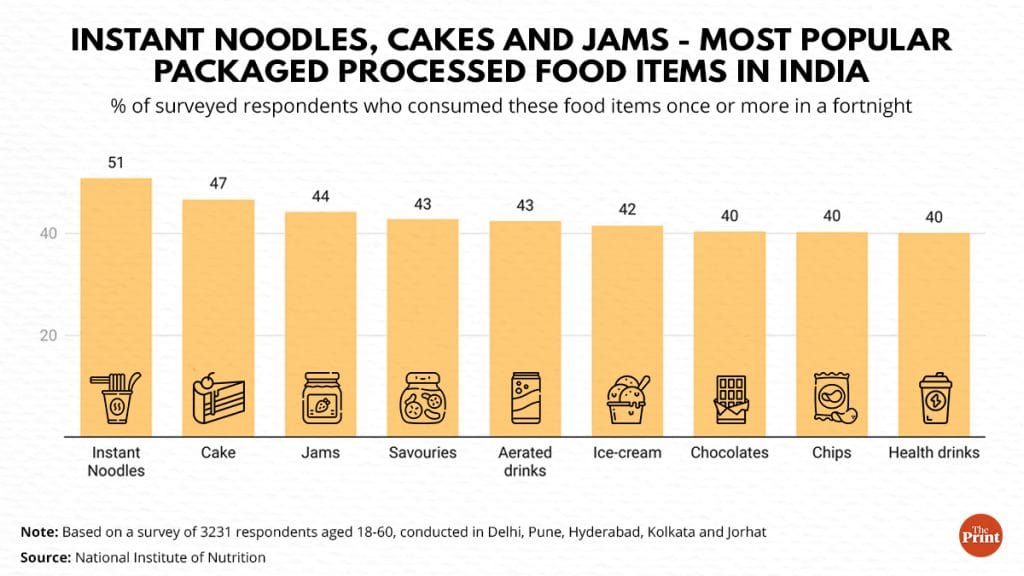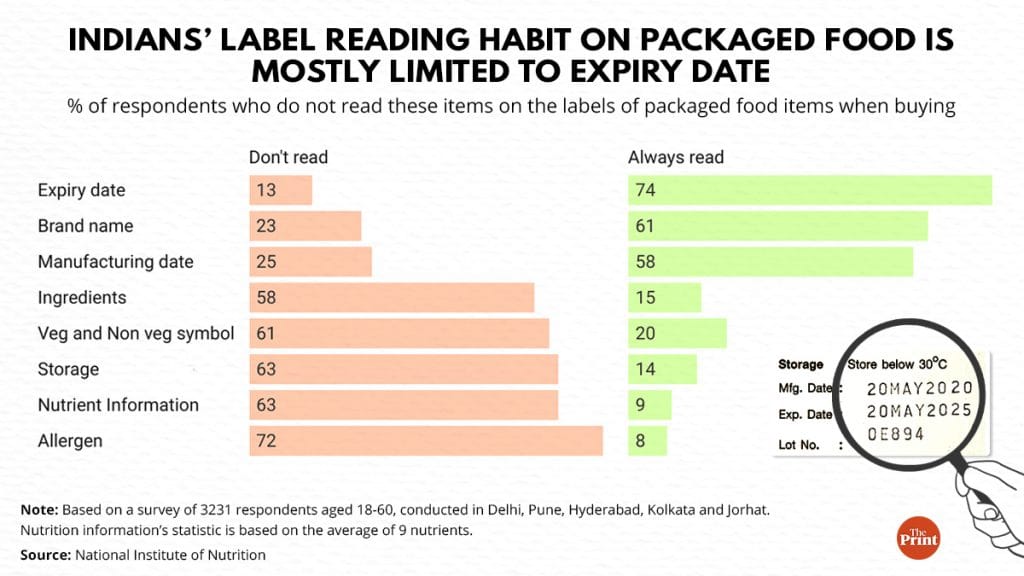New Delhi: Using symbols to show a product’s nutritional value on the front side of its packaging, rather than just numerical values, can influence a consumer’s decision to buy unhealthy packaged food, according to a survey by the Indian Council of Medical Research’s (ICMR) National Institute of Nutrition (NIN).
The survey, titled ‘Assessing effectiveness of front of pack nutrition labels for pre-packaged processed foods in India’, said most Indians read labels on packaged food items only to see the brand name and expiry date before purchasing, rather than check the nutritional values.
These labels are usually placed on the back of the pack and very few people check the nutritional value inscribed on them, according the survey published on 3 February.
The reason for this could be that the nutrition value inscribed on these packs is basically a table of text and numbers — which the data suggests has a lower uptake value compared to symbols such as the red and green dots (which indicate whether the product is non-vegetarian or vegetarian). Hence, the authors argue that the design of nutrition labels should also be lucid enough to influence consumer decisions while buying unhealthy processed foods.
Food labels mentioning nutritional values in India have been the norm ever since the government introduced the rule in 2011. This study, however, comes at a time when debates are taking place about exactly what kind of labels should be used.
Also Read: Cycling on Delhi streets? Study shows cyclists face 40 times higher threat to life
Different kinds of labels
To assess the effectiveness of different kinds of labels, the study team conducted an experiment using five types. One is Nutri-Score, a grading system using five alphabetical symbols coloured in five shades where A stands for the healthiest and E denotes the least healthy. The other systems include the Health Star Rating (stars showing how healthy an item is) and Warning Labels, which mark out certain ingredients of concern.

Lastly, there are Multiple Traffic Lights (showing information on nutrients — sugar, fat, saturated fats and calories, with coloured labels depicting health levels) and a Nutri Star Rating or NSR. This works by giving stars on a scale of one to five for each nutrient of concern based on how healthy it is.
These symbols were placed on the front side of a product named Relish, whose labelling was designed by the researchers.
According to the study, 93.5 per cent of respondents said that if a food item contained the Nutri-Score label with ‘E’ grade, they would not buy the product, while 92.4 per cent would reduce its consumption and 90.9 per cent would look for another product.
Broadly, placing any of these 5 labels would make consumers less likely to make a buying or substituting decision for the least healthy products, the study said.
However, the NIN suggests that each label can be used depending on the intention. For instance, if one wants to caution the consumer about high value of fat or sugar information, then warning labels could come in handy. For products with no substitutes, nutrition scores may not offer the best insight for picking alternatives.
“If the purpose of FOPNL (front-of-pack nutrition labelling) is to promote healthy food choices (based on the relative healthiness of the foods or the available variants of similar foods) then summary labels may be useful,” said NIN director Dr. Hemalatha R.
“Alternatively, in the context of growing issues like overweight, obesity and non-communicable diseases, if the FOPNL has to serve as a preventive tool and deter the consumers from consumption of nutrients of concern, then warning indicator labels (like WL and NSR in the current study) could be helpful,” she added.
India’s packaged food consumption
The study was conducted across five cities in India — Delhi, Pune, Kolkata, Hyderabad and Jorhat (in Assam) — with over 3,000 respondents aged between 18 and 60. This was done via a primary survey in which participants answered questions ranging from their packaged food consumption habits to reading labels carrying various bits of information.

According to the survey, instant noodles were the most commonly consumed processed food. About 51 per cent of the respondents reportedly consumed these items at least once or more in a fortnight.
At least 40 per cent of respondents consumed cake (46.7 per cent) and Jam (44.3 per cent) followed by savouries (42.8 per cent), aerated beverages (42.5 per cent), ice-cream (41.6 per cent), chocolate (40.4 per cent), chips (40.3 per cent) and health drinks (40.2 per cent) during the same time period. At least 36 per cent of the respondents reportedly consumed biscuits at least once a week, while 23.6 per cent ate chips, 22.8 per cent chocolates, 20.1 per cent savouries and 11.5 per cent had aerated drinks.
Also Read: Indians are growing fatter, and the problem is biggest for wealthy women, shows NFHS data
Label reading habits
The study also revealed that Indians do spend time on reading labels. However, it’s mostly done to check the brand name of the product and its expiry date.

According to the study, 74 per cent of the respondents always read the expiry date and 61 per cent always read the brand name. But very few pay heed to what is inside the pack.
Barely 9 per cent of respondents always read the nutritional value of the product. Nutritional value contains information on sugars, fats, trans fat, calories, carbohydrates, protein, salt, and cholesterol for every serving (or per 100 grams). In fact, the study showed that 63 per cent of respondents do not read the nutritional information labelled on the pack, while only 28 per cent read it sometimes.
Respondents’ attention to ingredients (42 per cent always or sometimes read), storage instructions (37 per cent) and allergen (29 per cent) was also low. The information placed on the front of the pack — the red and green dots — was read by 39 per cent of respondents (20 per cent always and 19 per cent sometimes), which the authors believe provides a case for front-of-pack labels.
“In the long run, it is recommended that ‘ultra-processed’ foods, whose basic edible and nutrient portions are greatly altered and those that have artificial ingredients, may be clearly indicated by a symbol or any such indicator right on the front of the pack. This is very important to promote informed and healthy food choices”, read one of NIN’s policy recommendations.
(Edited by Geethalakshmi Ramanathan)
Also Read: Why Delhi govt schools need classrooms more than teachers trained in Finland







The EIN (Employer Identification Number) is essential for U.S. LLCs — it’s your company’s tax ID, needed for banking and compliance.